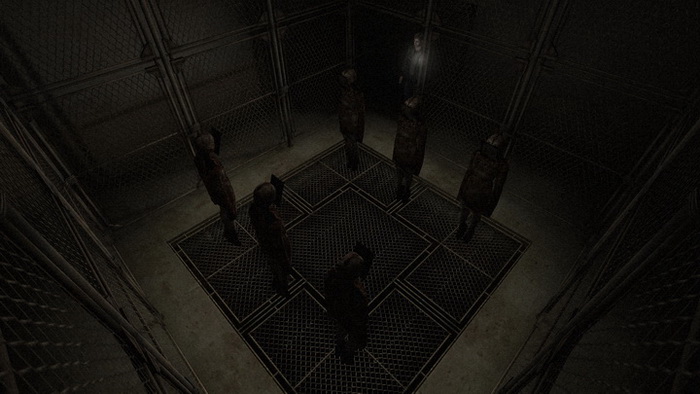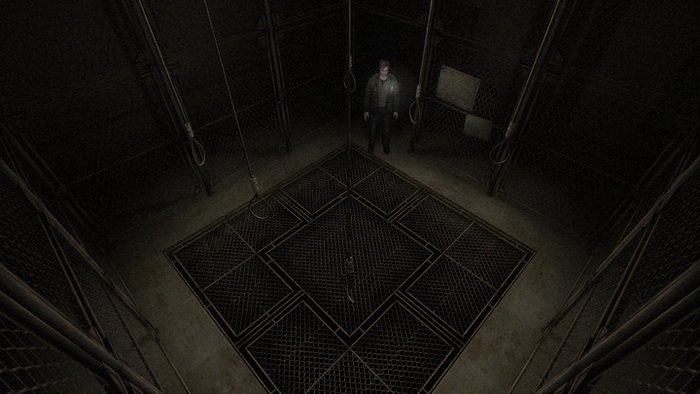Puzzles
Letter from Silent Heaven
01. Grandfather Clock (Apartments)
02. Safe Combination (Apartments)
03. Old Coin Desk (Apartments)
04. 3F Patient Wing Keypad (Hospital)
05. "Louise" Box (Hospital)
06. Trick or Treat Chest (Hospital)
07. Trap Room Keypad (Historical Society)
08. Box of Faces (Labyrinth)
09. Free the Innocent Man (Labyrinth)
10. Locked Briefcase (Hotel)
11. Music Box Player (Hotel)
Born from a Wish
Free the Innocent Man Puzzle (Labyrinth)
Contents
Video Guide |
Intro
The first thing you'll want to do is examine the two signs on the fence in the room with the six nooses. They should give you a clue as to what you have to do. The small sign is the same on all riddle levels and reads as follows:
Only the sinless one
can help you here.
Mistakenly pull on
a criminal's rope and
your reward will be returned
to you in a shape most
wondrously strange.
Six men were hanged and their corpses remain in the first room, each with an identifying plate over his head. Five of them were guilty while one was actually innocent. In addition to the smaller instruction sign in the noose room, you will find an in-depth riddle on the larger sign beside it that is the key to solving the puzzle.

The idea is to determine which of the six hanged men was actually innocent by deciphering the riddle. Then you must locate that man's corpse in the corpse room, using the identification cards on their front sides. Then you must note the location of that corpse in respect to the other men and move to the noose room, where you must pull the corresponding noose in the same position relative to the other nooses. Upon doing so, a key will appear in the corpse room in the place of the innocent man.
The innocent man will be different on each riddle level, however it will always be the same on those individual riddle levels. Despite this, the positions of the corpses and thus the correct noose will be randomized each time.
Depending on your riddle level, six of eight different criminals will appear in the corpse room. These are:
- Kidnapper - one who steals a human being
- Bodily Injurer - one who causes physical harm or injury
- Arsonist - one who maliciously sets fire to property
- Counterfeiter - one who copies with intent of forgery
- Thief - one who steals, especially by stealth
- Swindler - one who cheats or defrauds of money or property
- Embezzler - one who takes money for own use in violation of trust
- Murderer - one who brutally kills another
The same six of these eight will always appear on each individual riddle level, but some will not appear in other riddle levels.
Now we can move on to the meat of this puzzle, the riddle on the larger sign in the noose room. This will be different on each riddle level and will require its own deep examination for solving. Refer to below for the riddles and in-depth solutions.
Easy
He committed an evil crime.
He turned a happy home
into a pile of ash.
For that, he should die.They also committed crimes.
They tried to fraud
and trick others.
So their reward too is natural.Even he cannot be forgiven,
My friend without his left hand.
And so his death bothers me not.And what of him?
He also is not sinless.
There is only one here
who is innocent.The missing child was
nowhere to be found,
And so there was
no proof of his guilt.
His death was a tragedy.That is all I wish to say.
It was neither justice
nor retribution.
"He turned a happy home into a pile of ash" is very clear. The arsonist is guilty.
"They also committed crimes. They tried to fraud and trick others" describes three of the six accused men – the counterfeiter who tricks people with fake money or other items, the swindler who defrauds of money or property, and the thief who sneakily takes what is not his. They are all forms of fraud or trickery, and as described these men are all guilty.
"Even he cannot be forgiven, My friend without his hand. And so his death bothers me not" describes the bodily injurer, who causes harm or injury to another but not murder. So the bodily injurer is also guilty.
Then there's the final accused man: "There is only one here who is innocent. The missing child was nowhere to be found, And so there was no proof of his guilt." The kidnapper is the innocent man.
Normal
Dead men, dead men
swinging in a tree
How many dead men
do you see?
Tongue turned blue and
face gone grey
Watch them as they
twist and swayThe first one killed
the butcher man
Then cooked him in
the frying pan
Served him to his hungry guests
And gave them seconds on requestThe next one with his smile
and sweets
Stole poor children off the streets
To men who dressed unsavory
He sold them into slaveryBreaking into home at night
The thief he had a nasty fright
Filled his foolish head with ale
Woke in the morn
in the county jailThe artist with his daunting skill
Tried his hand at painting bills
But caught in rain he was undone
When the ink he'd use did
start to runWith promises of great return
Taking gold he did not earn
Bundled it up out of sight
Quietly slipped off into nightThree houses into ashes burned
The sheriff with no place to turn
Did spy a stranger to his town
Locked him up and beat him downDead men, dead men
swinging in a tree
How many dead men
do you see?
Six feet long and
six men wide
Round their necks
the noose be tied
After a fantastic introduction, our first clue is found in the second paragraph. "The first one killed the butcher man" refers to the murderer, who is certainly guilty. The rest is a nice little verse with more details but we already have the answer.
"The next one with his smile and sweets Stole poor children off the streets" obviously describes the kidnapper, so he's guilty too.
"Breaking into a home at night The thief he had a nasty fright" is also painfully obvious, making the thief guilty.
"The artist with his daunting skill tried his hand at painting bills" explains that an artist made counterfeit money, making him the counterfeiter and therefore guilty.
"Taking gold he did not earn" is the crime of embezzlement. Perhaps he worked at a bank with access to the gold in the vault. Either way, the embezzler is guilty.
That leaves us with five guilty men but one more potential criminal, the arsonist. "Three houses into ashes burned; The sheriff with no place to turn did spy a stranger to his town; Locked him up and beat him down". There is no proof that this poor man committed the crime and the sheriff only assumed he did. Therefore the arsonist is the innocent man.
Hard
I do not wish to die.
But tomorrow I will climb
the thirteen steps.Please someone - answer me,
Why must I die come the morning?The man imprisoned beside me
believed me. "Because they're
all insane, that's why," he said
Of course I know his opinion
will change nothing. "Now you
know why I struck out at them,"
he muttered.The man who was executed
yesterday, the one who had
said his job was to sell dreams,
said that was not true.But the man who is to be executed
the day after tomorrow for stealing
children shouted back that it was
true.The man who was hung today
did not answer. "They'll kill me
either way," he said. He was
caught embezzling public money,
so he hasn't any hope for mercy.The man who is always quietly
smiling to himself said "I am
happy for I will soon be with her."I do not wish to die.
I long only to return home.
But I know it is not to be.
Though I have done nothing, this
crime has been thrust upon me.Someone save me. This is not
judgement. They are bloodthirsty
and I am their sacrificial lamb!
Half of this riddle is very clear and half may take deeper examination. Let's go in order again, and note that the author appears to be one of the six accused men.
The third paragraph, which describes the first accused man, is quite difficult to understand. The man imprisoned beside the author of this riddle told him the reason he'll die come the morning is "Because they're all insane, that's why. Now you know why I struck out at them". The key here is the word "struck", which means to hit sharply, as with the hand, fist, or some form of weapon. This seems to describe the bodily injurer, who must've attacked and injured one or more of the prison guards while already in jail for another crime, or perhaps he even refers to everyone in the outside world after attacking someone. Either way, the bodily injurer is guilty.
"The man who was executed yesterday, the one who had said his job was to sell dreams, said that was not true." This next man sold "dreams" to people. Dreams that didn't come true. So he stole their money while giving promises of great return. This is the crime of swindling, so the swindler is guilty.
"But the man who is to be executed the day after tomorrow for stealing children shouted back that it was true." This clearly describes the kidnapper, who stole children, so he's guilty too.
In the next paragraph, the answer is given to you. In the third line we're told, "He was caught embezzling public money so he hasn't any hope for mercy." Crystal clear – the embezzler is guilty.
"The man who is always quietly smiling to himself said 'I am happy for I will soon be with her.'" This paragraph while not exactly direct should still make some sense. This matches the description of a crazy murderer, likely who killed his wife or a woman close to him whom he now misses and can't wait to see again in Heaven. But perhaps he's going somewhere else... Why did he kill her if he can't wait to see her now? Well, ask the crazy murderer, not me. Either way, the murderer is guilty.
The key to this riddle is in the last paragraphs, and we've already determined the five guilty men. "Though I have done nothing, this crime has been thrust upon me", says the author of the riddle, who is the sixth and final hanged man.
But how do we identify this innocent man? What was the crime he was accused of? Check the face plates in the corpse room to find the only unaccounted-for criminal is the counterfeiter. By process of elimination, the counterfeiter is the sacrificial lamb and innocent man.
Extra
We may visit death upon the head
of the sinner but to what avail?In the name of retribution,
we took part in a bitter
comedy this day.You, hanging as you do,
by your neck,
Unforgiven and cursed by all.Five of them committed crimes,
six went out for a drink and
were captured there.Only one of them was innocent,
but they knew not that.The bloodstains remaining
are proof of their guilt.
Trodden upon and thus created,
they are paths to
Hell or the Void.The white bandages stained
with crimson,
The remains upon the scorched
black earth,
The whispered cries of
the maiden.
They are but meaningless
contract.They are also signs of guilt.
But one of them was
done without reason.
It was done out of fear
and a ripe imagination.Sinning alone at the
end of a rope,
it is nothing less than
a disgrace to us all.
The first five paragraphs serve as a set up, however the sixth paragraph, "The bloodstains remaining are proof of their guilt", hints that the evidence of the crimes proves the guilt of the corresponding accused, or perhaps it just hints at the bodily injurer and murder crimes. So let's continue.
"The white bandages stained with crimson" brings two crimes to mind: bodily injury and murder. However bandages don't belong on a dead person as they will do nothing, so it has to be bodily injury.
"The remains upon the scorched black earth" is very clearly describing the remains of a fire, which burns and turns things black. Arson.
The next phrase, "The whispered cries of the maiden", describes an unmarried woman trying to scream, but all that comes out is a whimper or a whisper since she's terrified. You may be able to relate to this if you've ever had a dream where you tried to scream but couldn't for the life of you let it out. This definitely describes the crime of kidnapping.
"They are but a meaningless contract" is a bare sentence adding onto the three crimes already mentioned and its meaning is deep inside, so you really have to think about it. It may not even appear to be referring to one of the criminals at first glance and rather just back to the first three, but it is the only sentence that seems to tackle the following crime, so let's break it down.
A contract is an agreement, but it is meaningless if you're not going to follow it. So far the unspoken crimes are thievery, murder, and swindling. Swindling is cheating or defrauding of money or property, and this phrase could be interpreted as breaking a contract, potentially to illegally obtain money or property through deception. So the swindler fits here.
The next paragraph, "They are also signs of guilt", confirms our earlier suggestion that the evidence of the crimes indicates the guilt of the corresponding criminals. So the bodily injurer, arsonist, kidnapper and swindler are certainly guilty.
The second last paragraph isn't that clear either, but it's a bit easier to follow. "But one of them was done without reason. It was done out of fear and a ripe imagination." Without reason, eh? We only have thievery and murder left. Can you steal something out of fear and a ripe imagination? I mean, who knows, but it doesn't really make sense, does it? But could you kill someone out of fear? Absolutely. An example would be self-defense. Elaborating, the ripe imagination could be from this person thinking they were going to be killed by the other, perhaps jumping to extreme conclusions to arrive there, so they thought it was kill or be killed. Either way, the answer here is murder, making the murderer guilty.
Only five of the six men have been mentioned in this riddle, so what's this all about? What about the other guy? Well, we've determined which five men are guilty, so that leaves the final accused as the innocent man. The only unaccounted-for accused in the corpse room is the thief, who was never mentioned in the riddle, and thus he is the innocent man.
Locating the Innocent Man
Once you determine the innocent man, locate him in the corpse room. Full solutions are above, but for quick reference these are the innocent men for each riddle level:
- Easy: Kidnapper
- Normal: Arsonist
- Hard: Counterfeiter
- Extra: Thief
Note the innocent man's position out of the six men by reading the face plates, then head over to the room with six empty nooses. Here, find the noose in the same position as the innocent man in the other room in respect to all the nooses. Then move up to it and examine it to pull it down. Do not pull any other ropes as this will undo your answer. If you do pull the wrong one first by accident, just pull the correct one after.

Now head back to the corpse room. If you pulled the correct noose in the other room, the innocent man will now be gone in this room and in his place will be the Key of the Persecuted.
Each time you pull an incorrect noose and go check the other room to confirm it was wrong, there will then be 2-4 Lying Figures in the connecting corridor. This would be your reward "in a shape most wondrously strange", as described on the sign in the noose room. Make sure you're right the first time you pull to avoid this.
by Andrew Haffenden aka Conquerer (Silent Hill 2 Puzzle Guide) |
